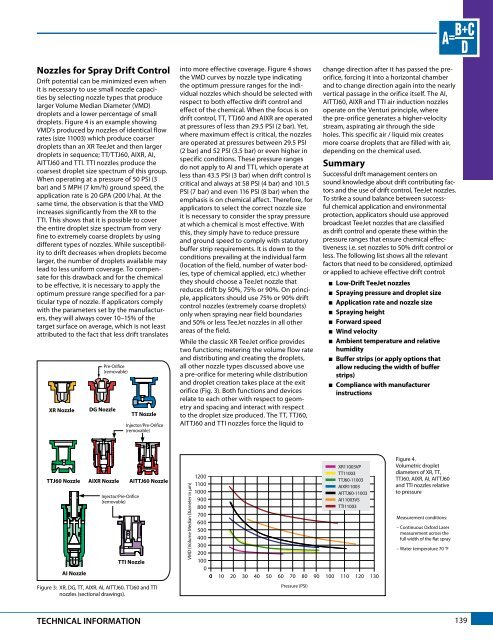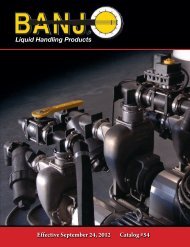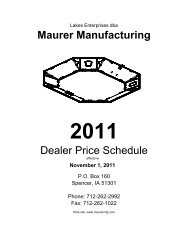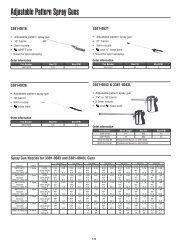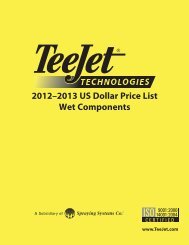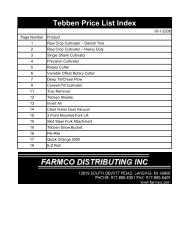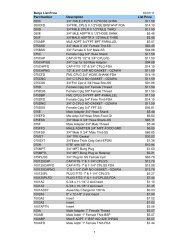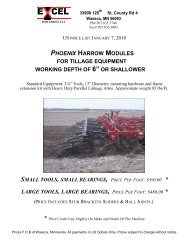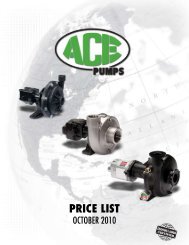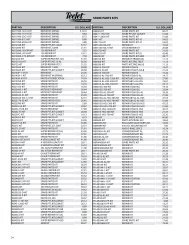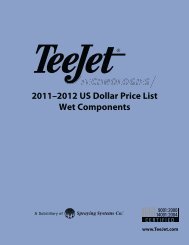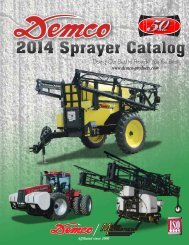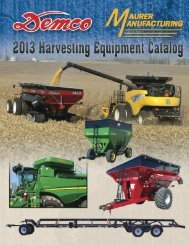Teejet Catalog 51 - Farmco Distributing Inc
Teejet Catalog 51 - Farmco Distributing Inc
Teejet Catalog 51 - Farmco Distributing Inc
Create successful ePaper yourself
Turn your PDF publications into a flip-book with our unique Google optimized e-Paper software.
Nozzles for Spray Drift Control<br />
Drift potential can be minimized even when<br />
it is necessary to use small nozzle capacities<br />
by selecting nozzle types that produce<br />
larger Volume Median Diameter (VMD)<br />
droplets and a lower percentage of small<br />
droplets. Figure 4 is an example showing<br />
VMD’s produced by nozzles of identical flow<br />
rates (size 11003) which produce coarser<br />
droplets than an XR TeeJet and then larger<br />
droplets in sequence; TT/TTJ60, AIXR, AI,<br />
AITTJ60 and TTI. TTI nozzles produce the<br />
coarsest droplet size spectrum of this group.<br />
When operating at a pressure of 50 PSI (3<br />
bar) and 5 MPH (7 km/h) ground speed, the<br />
application rate is 20 GPA (200 l/ha). At the<br />
same time, the observation is that the VMD<br />
increases significantly from the XR to the<br />
TTI. This shows that it is possible to cover<br />
the entire droplet size spectrum from very<br />
fine to extremely coarse droplets by using<br />
different types of nozzles. While susceptibility<br />
to drift decreases when droplets become<br />
larger, the number of droplets available may<br />
lead to less uniform coverage. To compensate<br />
for this drawback and for the chemical<br />
to be effective, it is necessary to apply the<br />
optimum pressure range specified for a particular<br />
type of nozzle. If applicators comply<br />
with the parameters set by the manufacturers,<br />
they will always cover 10–15% of the<br />
target surface on average, which is not least<br />
attributed to the fact that less drift translates<br />
XR Nozzle<br />
Pre-Orifice<br />
(removable)<br />
DG Nozzle<br />
TT Nozzle<br />
Injector/Pre-Orifice<br />
(removable)<br />
into more effective coverage. Figure 4 shows<br />
the VMD curves by nozzle type indicating<br />
the optimum pressure ranges for the individual<br />
nozzles which should be selected with<br />
respect to both effective drift control and<br />
effect of the chemical. When the focus is on<br />
drift control, TT, TTJ60 and AIXR are operated<br />
at pressures of less than 29.5 PSI (2 bar). Yet,<br />
where maximum effect is critical, the nozzles<br />
are operated at pressures between 29.5 PSI<br />
(2 bar) and 52 PSI (3.5 bar) or even higher in<br />
specific conditions. These pressure ranges<br />
do not apply to AI and TTI, which operate at<br />
less than 43.5 PSI (3 bar) when drift control is<br />
critical and always at 58 PSI (4 bar) and 101.5<br />
PSI (7 bar) and even 116 PSI (8 bar) when the<br />
emphasis is on chemical affect. Therefore, for<br />
applicators to select the correct nozzle size<br />
it is necessary to consider the spray pressure<br />
at which a chemical is most effective. With<br />
this, they simply have to reduce pressure<br />
and ground speed to comply with statutory<br />
buffer strip requirements. It is down to the<br />
conditions prevailing at the individual farm<br />
(location of the field, number of water bodies,<br />
type of chemical applied, etc.) whether<br />
they should choose a TeeJet nozzle that<br />
reduces drift by 50%, 75% or 90%. On principle,<br />
applicators should use 75% or 90% drift<br />
control nozzles (extremely coarse droplets)<br />
only when spraying near field boundaries<br />
and 50% or less TeeJet nozzles in all other<br />
areas of the field.<br />
While the classic XR TeeJet orifice provides<br />
two functions; metering the volume flow rate<br />
and distributing and creating the droplets,<br />
all other nozzle types discussed above use<br />
a pre-orifice for metering while distribution<br />
and droplet creation takes place at the exit<br />
orifice (Fig. 3). Both functions and devices<br />
relate to each other with respect to geometry<br />
and spacing and interact with respect<br />
to the droplet size produced. The TT, TTJ60,<br />
AITTJ60 and TTI nozzles force the liquid to<br />
change direction after it has passed the preorifice,<br />
forcing it into a horizontal chamber<br />
and to change direction again into the nearly<br />
vertical passage in the orifice itself. The AI,<br />
AITTJ60, AIXR and TTI air induction nozzles<br />
operate on the Venturi principle, where<br />
the pre-orifice generates a higher-velocity<br />
stream, aspirating air through the side<br />
holes. This specific air / liquid mix creates<br />
more coarse droplets that are filled with air,<br />
depending on the chemical used.<br />
Summary<br />
Successful drift management centers on<br />
sound knowledge about drift contributing factors<br />
and the use of drift control, TeeJet nozzles.<br />
To strike a sound balance between successful<br />
chemical application and environmental<br />
protection, applicators should use approved<br />
broadcast TeeJet nozzles that are classified<br />
as drift control and operate these within the<br />
pressure ranges that ensure chemical effectiveness;<br />
i.e. set nozzles to 50% drift control or<br />
less. The following list shows all the relevant<br />
factors that need to be considered, optimized<br />
or applied to achieve effective drift control:<br />
K Low-Drift TeeJet nozzles<br />
K Spraying pressure and droplet size<br />
K Application rate and nozzle size<br />
K Spraying height<br />
K Forward speed<br />
K Wind velocity<br />
K Ambient temperature and relative<br />
humidity<br />
K Buffer strips (or apply options that<br />
allow reducing the width of buffer<br />
strips)<br />
K Compliance with manufacturer<br />
instructions<br />
TTJ60 Nozzle<br />
AI Nozzle<br />
AIXR Nozzle<br />
Injector/Pre-Orifice<br />
(removable)<br />
AITTJ60 Nozzle<br />
TTI Nozzle<br />
Figure 3: XR, DG, TT, AIXR, AI, AITTJ60, TTJ60 and TTI<br />
nozzles (sectional drawings).<br />
VMD (Volume Median Diameter in μm)<br />
1200<br />
1100<br />
1000<br />
900<br />
800<br />
700<br />
600<br />
500<br />
400<br />
300<br />
200<br />
100<br />
0<br />
XR11003VP<br />
TT11003<br />
TTJ60-11003<br />
AIXR11003<br />
AITTJ60-11003<br />
AI11003VS<br />
TTI11003<br />
0 10 20 30 40 50 60 70 80 90 100 110 120 130<br />
Pressure (PSI)<br />
Figure 4.<br />
Volumetric droplet<br />
diameters of XR, TT,<br />
TTJ60, AIXR, AI, AITTJ60<br />
and TTI nozzles relative<br />
to pressure<br />
Measurement conditions:<br />
– Continuous Oxford Laser<br />
measurement across the<br />
full width of the flat spray<br />
– Water temperature 70 °F<br />
TECHNICAL INFORMATION<br />
139


